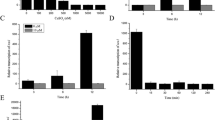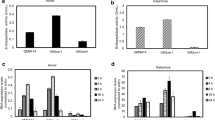Abstract
Trichoderma reesei represents an important workhorse for industrial production of cellulases as well as other proteins. The molecular mechanism underlying the regulation of cellulase production as well as other physiological processes in T. reesei is still insufficiently understood. We constructed a P tcu1 -based promoter substitution cassette that allowed one-step replacement of the endogenous promoter for controlling the target gene expression with copper. We then showed that copper repression of the histone acetyltransferase gene gcn5 phenocopied the gcn5 deletion strain. Using the same strategy, we further characterized the function of another putative Spt-Ada-Gcn5 acetyltransferase (SAGA) complex subunit encoding gene, ada2, in T. reesei. Similar to the repression of gcn5, the addition of copper to the P tcu1 -ada2 strain not only drastically reduced the vegetative growth and conidiation in T. reesei but also severely compromised the induced cellulase gene expression. The developed strategy will thus be potentially useful to probe the biological function of the large fraction of T. reesei genes with unknown functions including those essential genes in the genome to expand its extraordinary biotechnological potential.







Similar content being viewed by others
References
Balasubramanian R, Pray-Grant MG, Selleck W, Grant PA, Tan S (2002) Role of the Ada2 and Ada3 transcriptional coactivators in histone acetylation. J Biol Chem 277(10):7989–7995. doi:10.1074/jbc.M110849200
Belli G, Gari E, Aldea M, Herrero E (1998) Functional analysis of yeast essential genes using a promoter-substitution cassette and the tetracycline-regulatable dual expression system. Yeast 14(12):1127–1138. doi:10.1002/(sici)1097-0061
Breslow DK, Cameron DM, Collins SR, Schuldiner M, Stewart-Ornstein J, Newman HW, Braun S, Madhani HD, Krogan NJ, Weissman JS (2008) A comprehensive strategy enabling high-resolution functional analysis of the yeast genome. Nat Methods 5(8):711–718. doi:10.1038/nmeth.1234
Geever RF, Baum JA, Case ME, Giles NH (1987) Regulation of the QA gene cluster of Neurospora crassa. Antonie Van Leeuwenhoek 53(5):343–348. doi:10.1007/bf00400558
Giles NH, Case ME, Baum J, Geever R, Huiet L, Patel V, Tyler B (1985) Gene organization and regulation in the qa (quinic acid) gene cluster of Neurospora crassa. Microbiol Rev 49(3):338–358
Grant PA, Duggan L, Cote J, Roberts SM, Brownell JE, Candau R, Ohba R, Owen-Hughes T, Allis CD, Winston F, Berger SL, Workman JL (1997) Yeast Gcn5 functions in two multisubunit complexes to acetylate nucleosomal histones: characterization of an Ada complex and the SAGA (Spt/Ada) complex. Genes Dev 11(13):1640–1650. doi:10.1101/gad.11.13.1640
Gruber F, Visser J, Kubicek CP, de Graaff LH (1990) The development of a heterologous transformation system for the cellulolytic fungus Trichoderma reesei based on a pyrG-negative mutant strain. Curr Genet 18(1):71–76. doi:10.1007/bf00321118
Haruki H, Nishikawa J, Laemmli UK (2008) The anchor-away technique: rapid, conditional establishment of yeast mutant phenotypes. Mol Cell 31(6):925–932. doi:10.1016/j.molcel.2008.07.020
Hu W, Sillaots S, Lemieux S, Davison J, Kauffman S, Breton A, Linteau A, Xin C, Bowman J, Becker J, Jiang B, Roemer T (2007) Essential gene identification and drug target prioritization in Aspergillus fumigatus. PLoS Pathog 3(3):e24. doi:10.1371/journal.ppat.0030024
Iwata A, Alshahni MM, Nishiyama Y, Makimura K, Abe S, Yamada T (2012) Development of a tightly regulatable copper-mediated gene switch system in dermatophytes. Appl Environ Microbiol 78(15):5204–5211. doi:10.1128/aem.00464-12
Lamb TM, Vickery J, Bell-Pedersen D (2013) Regulation of gene expression in Neurospora crassa with a copper responsive promoter. G3 (Bethesda) 3(12):2273–2280. doi:10.1534/g3.113.008821
Liu R, Chen L, Jiang Y, Zhou Z, Zou G (2015) Efficient genome editing in filamentous fungus Trichoderma reesei using the CRISPR/Cas9 system. Cell Discovery 1:15007. doi:10.1038/celldisc.2015.7
Lv X, Zhang W, Chen G, Liu W (2015a) Trichoderma reesei Sch9 and Yak1 regulate vegetative growth, conidiation, and stress response and induced cellulase production. J Microbiol. doi:10.1007/s12275-015-4639-x
Lv X, Zheng F, Li C, Zhang W, Chen G, Liu W (2015b) Characterization of a copper responsive promoter and its mediated overexpression of the xylanase regulator 1 results in an induction-independent production of cellulases in Trichoderma reesei. Biotechnol Biofuels 8:67. doi:10.1186/s13068-015-0249-4
Martinez D, Berka RM, Henrissat B, Saloheimo M, Arvas M, Baker SE, Chapman J, Chertkov O, Coutinho PM, Cullen D, Danchin EGJ, Grigoriev IV, Harris P, Jackson M, Kubicek CP, Han CS, Ho I, Larrondo LF, de Leon AL, Magnuson JK, Merino S, Misra M, Nelson B, Putnam N, Robbertse B, Salamov AA, Schmoll M, Terry A, Thayer N, Westerholm-Parvinen A, Schoch CL, Yao J, Barbote R, Nelson MA, Detter C, Bruce D, Kuske CR, Xie G, Richardson P, Rokhsar DS, Lucas SM, Rubin EM, Dunn-Coleman N, Ward M, Brettin TS (2008) Genome sequencing and analysis of the biomass-degrading fungus Trichoderma reesei (syn. Hypocrea jecorina). Nat Biotechnol 26(5):553–560. doi:10.1038/nbt1403
Mello-de-Sousa TM, Rassinger A, Pucher ME, dos Santos CL, Persinoti GF, Silva-Rocha R, Pocas-Fonseca MJ, Mach RL, Nascimento Silva R, Mach-Aigner AR (2015) The impact of chromatin remodelling on cellulase expression in Trichoderma reesei. BMC Genomics 16:588. doi:10.1186/s12864-015-1807-7
Mello-de-Sousa TM, Rassinger A, Derntl C, Pocas-Fonseca MJ, Mach RL, Mach-Aigner AR (2016) The relation between promoter chromatin status, Xyr1 and cellulase expression in Trichoderma reesei. Current genomics 17(2):145–152. doi:10.2174/1389202917666151116211812
Meyer V, Wanka F, van Gent J, Arentshorst M, van den Hondel CA, Ram AF (2011) Fungal gene expression on demand: an inducible, tunable, and metabolism-independent expression system for Aspergillus niger. Appl Environ Microbiol 77(9):2975–2983. doi:10.1128/aem.02740-10
Mnaimneh S, Davierwala AP, Haynes J, Moffat J, Peng WT, Zhang W, Yang X, Pootoolal J, Chua G, Lopez A, Trochesset M, Morse D, Krogan NJ, Hiley SL, Li Z, Morris Q, Grigull J, Mitsakakis N, Roberts CJ, Greenblatt JF, Boone C, Kaiser CA, Andrews BJ, Hughes TR (2004) Exploration of essential gene functions via titratable promoter alleles. Cell 118(1):31–44. doi:10.1016/j.cell.2004.06.013
Nakayama H, Izuta M, Nagahashi S, Sihta EY, Sato Y, Yamazaki T, Arisawa M, Kitada K (1998) A controllable gene-expression system for the pathogenic fungus Candida glabrata. Microbiology 144(Pt 9):2407–2415. doi:10.1099/00221287-144-9-2407
Ory JJ, Griffith CL, Doering TL (2004) An efficiently regulated promoter system for Cryptococcus neoformans utilizing the CTR4 promoter. Yeast 21(11):919–926. doi:10.1002/yea.1139
Ouedraogo JP, Arentshorst M, Nikolaev I, Barends S, Ram AF (2015) I-SceI-mediated double-strand DNA breaks stimulate efficient gene targeting in the industrial fungus Trichoderma reesei. Appl Microbiol Biotechnol. doi:10.1007/s00253-015-6829-1
Penttila M, Nevalainen H, Ratto M, Salminen E, Knowles J (1987) A versatile transformation system for the cellulolytic filamentous fungus Trichoderma reesei. Gene 61(2):155–164. doi:10.1016/0378-1119(87)90110-7
Rahman Z, Shida Y, Furukawa T, Suzuki Y, Okada H, Ogasawara W, Morikawa Y (2009) Evaluation and characterization of Trichoderma reesei cellulase and xylanase promoters. Appl Microbiol Biotechnol 82(5):899–908. doi:10.1007/s00253-008-1841-3
Ramirez-Zavala B, Mogavero S, Scholler E, Sasse C, Rogers PD, Morschhauser J (2014) SAGA/ADA complex subunit Ada2 is required for Cap1- but not Mrr1-mediated upregulation of the Candida albicans multidrug efflux pump MDR1. Antimicrob Agents Chemother 58(9):5102–5110. doi:10.1128/aac.03065-14
Roemer T, Jiang B, Davison J, Ketela T, Veillette K, Breton A, Tandia F, Linteau A, Sillaots S, Marta C, Martel N, Veronneau S, Lemieux S, Kauffman S, Becker J, Storms R, Boone C, Bussey H (2003) Large-scale essential gene identification in Candida albicans and applications to antifungal drug discovery. Mol Microbiol 50(1):167–181
Romero B, Turner G, Olivas I, Laborda F, De Lucas JR (2003) The Aspergillus nidulans alcA promoter drives tightly regulated conditional gene expression in Aspergillus fumigatus permitting validation of essential genes in this human pathogen. Fungal Genet Biol 40(2):103–114
Samara NL, Wolberger C (2011) A new chapter in the transcription SAGA. Curr Opin Struct Biol 21(6):767–774. doi:10.1016/j.sbi.2011.09.004
Sauer B (2002) Cre/lox: one more step in the taming of the genome. Endocrine 19(3):221–228
Sellam A, Askew C, Epp E, Lavoie H, Whiteway M, Nantel A (2009) Genome-wide mapping of the coactivator Ada2p yields insight into the functional roles of SAGA/ADA complex in Candida albicans. Mol Biol Cell 20(9):2389–2400. doi:10.1091/mbc.E08-11-1093
Stricker AR, Mach RL, de Graaff LH (2008) Regulation of transcription of cellulases- and hemicellulases-encoding genes in Aspergillus niger and Hypocrea jecorina (Trichoderma reesei). Appl Microbiol Biotechnol 78(2):211–220. doi:10.1007/s00253-007-1322-0
Syntichaki P, Thireos G (1998) The Gcn5 {middle dot} Ada complex potentiates the histone acetyltransferase activity of Gcn5. J Biol Chem 273(38):24414–24419. doi:10.1074/jbc.273.38.24414
Tamura K, Peterson D, Peterson N, Stecher G, Nei M, Kumar S (2011) MEGA5: molecular evolutionary genetics analysis using maximum likelihood, evolutionary distance, and maximum parsimony methods. Mol Biol Evol 28(10):2731–2739. doi:10.1093/molbev/msr121
Timmers HT, Tora L (2005) SAGA unveiled. Trends Biochem Sci 30(1):7–10. doi:10.1016/j.tibs.2004.11.007
Vogt K, Bhabhra R, Rhodes JC, Askew DS (2005) Doxycycline-regulated gene expression in the opportunistic fungal pathogen Aspergillus fumigatus. BMC Microbiol 5:1. doi:10.1186/1471-2180-5-1
Wang L, Mizzen C, Ying C, Candau R, Barlev N, Brownell J, Allis CD, Berger SL (1997) Histone acetyltransferase activity is conserved between yeast and human GCN5 and is required for complementation of growth and transcriptional activation. Mol Cell Biol 17(1):519–527
Willyerd KL, Kemp AM, Dawe AL (2009) Controlled gene expression in the plant pathogen Cryphonectria parasitica by use of a copper-responsive element. Appl Environ Microbiol 75(16):5417–5420. doi:10.1128/aem.00899-09
Xin Q, Gong Y, Lv X, Chen G, Liu W (2013) Trichoderma reesei histone acetyltransferase Gcn5 regulates fungal growth, conidiation, and cellulase gene expression. Curr Microbiol 67(5):580–589. doi:10.1007/s00284-013-0396-4
Xu J, Zhao G, Kou Y, Zhang W, Zhou Q, Chen G, Liu W (2014) Intracellular beta-glucosidases CEL1a and CEL1b are essential for cellulase induction on lactose in Trichoderma reesei. Eukaryot Cell 13(8):1001–1013. doi:10.1128/ec.00100-14
Zhou Q, Xu J, Kou Y, Lv X, Zhang X, Zhao G, Zhang W, Chen G, Liu W (2012) Differential involvement of beta-glucosidases from Hypocrea jecorina in rapid induction of cellulase genes by cellulose and cellobiose. Eukaryotic cell 11(11):1371–1381. doi:10.1128/ec.00170-12
Acknowledgements
This work is supported by grants from the National Natural Science Foundation of China (31270116, 31470162, and 31300059) and National Key Technology Support Program (2015BAD15B05). Zhang WX would also like to acknowledge the support from the Scientific Research Foundation for Excellent Young and Middle-Aged Scientists of Shandong Province of China (BS2013NJ021) and China Postdoctoral Science Foundation (2012M521325).
Author information
Authors and Affiliations
Corresponding author
Ethics declarations
Conflict of interest
The authors declare that they have no competing interests.
Research involving human participants and/or animals
This article does not contain any studies with human participants or animals performed by any of the authors.
Rights and permissions
About this article
Cite this article
Zheng, F., Cao, Y., Lv, X. et al. A copper-responsive promoter replacement system to investigate gene functions in Trichoderma reesei: a case study in characterizing SAGA genes. Appl Microbiol Biotechnol 101, 2067–2078 (2017). https://doi.org/10.1007/s00253-016-8036-0
Received:
Revised:
Accepted:
Published:
Issue Date:
DOI: https://doi.org/10.1007/s00253-016-8036-0




